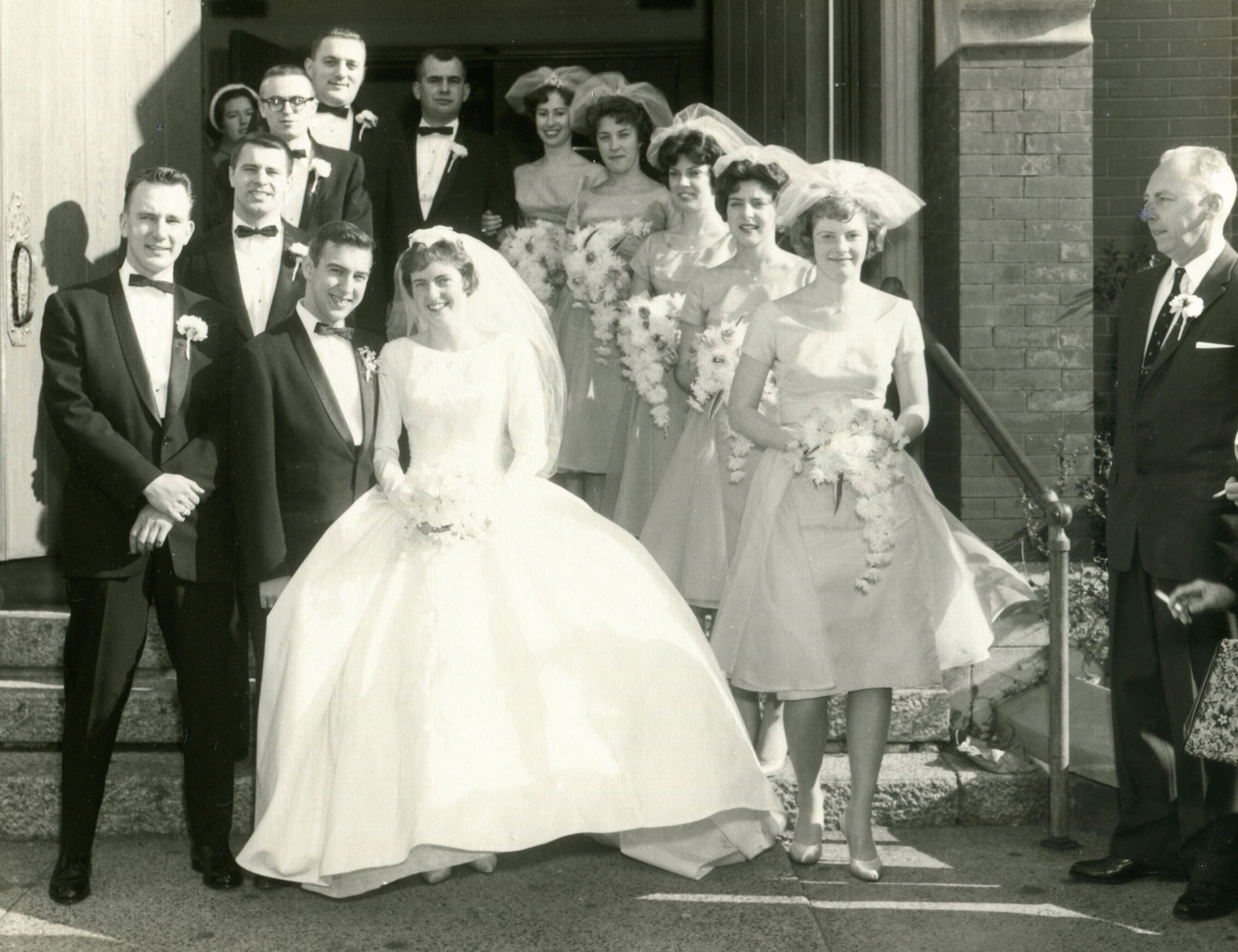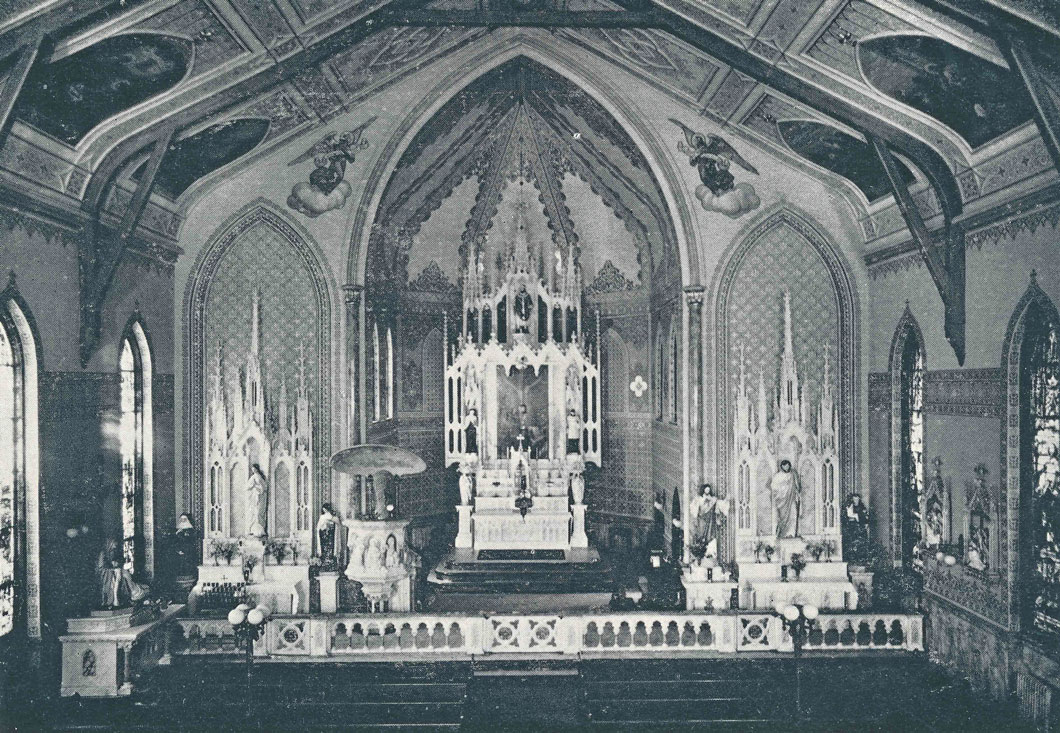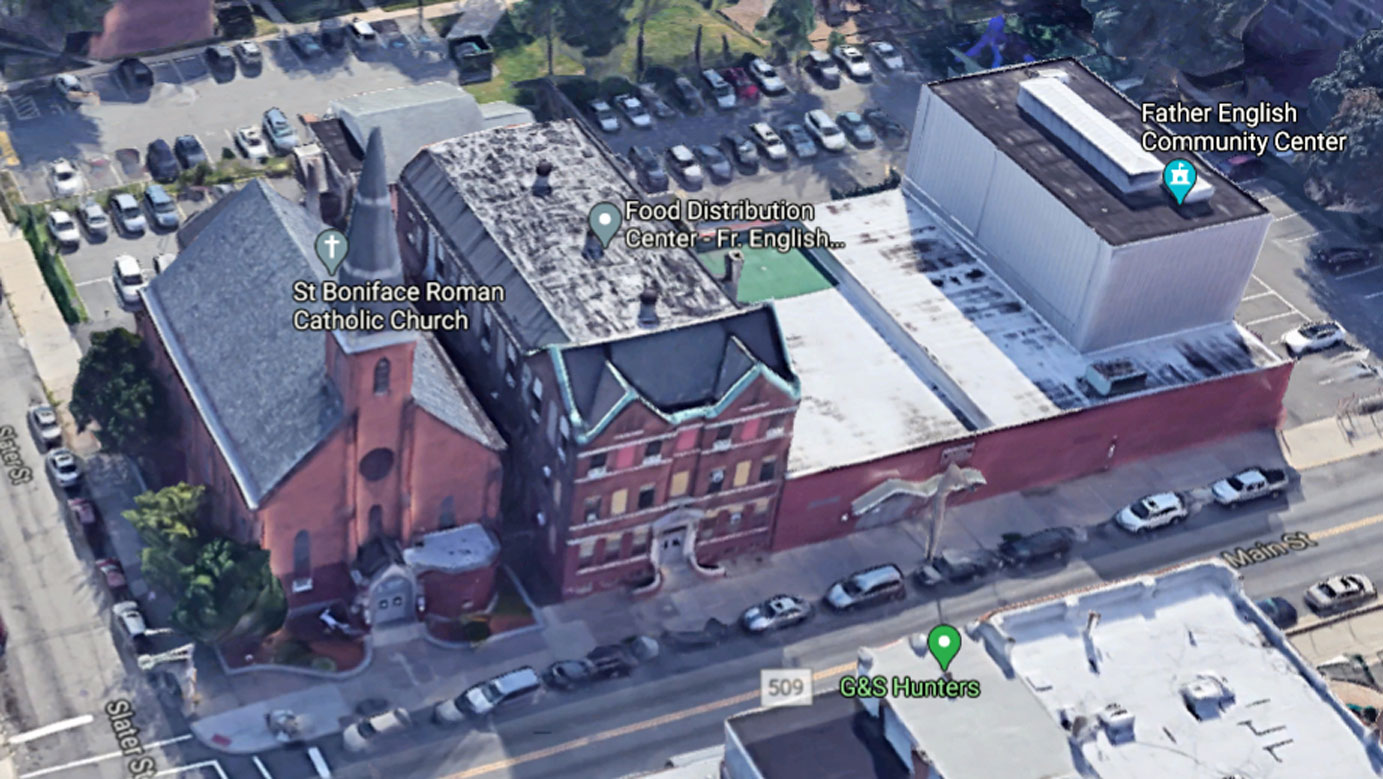The tide of European immigration in the late 19th and early 20th centuries swelled the ranks of New Jersey's Catholics. Before the erection of the present church of St. Boniface, the few German families of the city of Paterson gathered once a month or once a fortnight in the basement of old St. John's Church to have special German services. They were visited by Rev. P. Hartlaub, who from October 1853, till April 1858, zealously responded to their spiritual wants.
In August 1859, Father John J. Schandel was appointed permanent priest for the Germans. The German Catholics in Paterson were few in number and not blessed with worldly riches so Father Schandel was obliged to work for his support in outside missions. He worked very hard among his countrymen and it was he who conceived the idea and furthered the project of building a church for German Catholics. He purchased 10 lots on the corner of Main and Slater streets where St. Boniface's Church now stands, and erected that structure with a seating capacity of 900. The corner-stone was laid on July 1st, 1860, by Bishop Bayley, and after completion the church was blessed December 1st, 1861. St. Boniface's Church had the honor of being the oldest church in the city of Paterson.
Rt. Rev. Bishop Bayley kept a journal of the more important actions of his life and from this journal the following extract is made: "On Sunday, July 1st, 1860, at half past five, I laid the corner stone of the new German Catholic Church of St. Boniface, which Father Schandel is endeavoring to build. We went in procession to the spot — the cross before, with acolytes, children — Erin's Society as a guard—banners flying — the big missionary cross borne before my carriage by the Germans. There must have been from 8,000 to 10,000 persons present — hot and dusty, but no disturbance. I pitched into Martin Luther for the edification of the multitude."
In September 1864 the church was incorporated under the legal title 'Saint Boniface's Catholic Church, Paterson.'
The silk mills at this time attracted large numbers of persons to Paterson and Father Schandel concluded that it would be well to erect the Catholics in Passaic into a separate congregation. Bishop Bayley thought well of the plan and on July 1871, Father Schandel was transferred to Passaic and Father Nicholas Hens, who was appointed as the first assistant in September 1869, was appointed pastor of St. Boniface's in January 1872.
The German Catholics of this vicinity did a great deal towards establishing the Catholic Church on the firm footing it has found in this county and too much praise cannot be bestowed on the work of the early German Catholics and their priests. A prominent figure in the work among the German Catholics was Father Hens, the respected and zealous pastor of St. Boniface's Church, who spent the best days of an active and useful life among the German Catholics.
Father Hens brought the Sisters of St. Dominic to his parish in September 1872, and having procured two lots built the Saint Boniface school in 1875.
 |
| 1962 - One of many family weddings at Saint Boniface. |
About this time (1879) the congregation sustained a serious loss in its membership, twenty families leaving it to attend St. Mary's Church on Totowa for greater convenience, and the thirty-five families residing in the Stony Road district allying themselves to St. Bonaventure's Church.
Despite this defection the congregation of St. Boniface continued to grow, and soon the church was not able to hold all that wished to worship within its walls. On March 19th, 1882, the feast of St. Joseph, the patron of the Catholic Church, Father Hens bought a plot of ground on River street, near the crossing of the New York, Lake Erie and Western Railroad. Here the corner-stone of a new church was laid on September 4th, 1882, and on May 14th in the following year the new church was dedicated by Rt. Rev. Bishop Wigger. The church was placed under the protection of Our Lady of Lourdes. The erection of this church cut off from St. Boniface's congregation over one hundred German and Holland families, but their places were soon filled, so that six months after the dedication of the new church, St. Boniface's congregation was as large as it ever was. Three masses were said every Sunday and the church was crowded every time. The number of families belonging to the church was about 400, and its parochial schools had an attendance of 350.
For a long time the French and Italian residents of Paterson worshipped in the churches which were most convenient to them, and no attempt was made to provide for them opportunities to attend services in their own language. In 1882 Father Hens induced some of the Fathers of Mercy from New York to come to Paterson occasionally, and services were for some time held in French and Italian in St. Boniface's Church. The numbers of attendants at these services increased, and in 1883 they rented a room in the Smith and Jackson building in Market street. Here religious services are held every Sunday, Father Porcille, one of the Fathers of Mercy in New York, coming to Paterson every Saturday and returning to New York on Monday.
In 1904 and 1905 the old school was demolished and a new one built. At the same time the church itself was refurbished such that by 1905 the parish was heavily in debt. For many years the pastor had to personally solicit annual subscriptions to meet interest fees and begin to pay off the debt.
In 1911, still in debt, and the Golden Jubilee approaching, the church was in need of repairs and a complete renovation and repair of the church was undertaken. The interior was completely rebuilt and decorated. The exterior was partly remodeled, repaired and painted. For the next 10 years fund raising was a focus.
In 1936 the interior of the church was again totally refurbished. Over the years adjoining properties were purchased as they became available for playgrounds and expansion.
In the 20th Century church life was very active involving the whole family. There were German dinners, Bingo several times a week, and celebrations on holidays and holy days. The church sponsored bowling teams, a dramatic and social club, Holy Name society for both youth and adults and a Rosary Society.
For children born into Saint Boniface and attending school there the church was central to their life. They mingled with other German speakers and became familiar with German culture. It was a natural place for new immigrants to find a home and assistance with assimilating into their new American life.
By the 1960's the ethnic population of Paterson was changing. The Germans were moving to the suburbs and there was a need for masses in Spanish. Consequently Saint Boniface began changing to meet this need and German masses no longer dominated.
At this time the Catholic population in Paterson was declining such that fewer churches and schools were required and were being merged with other parishes. Saint Boniface's school was merged in 1974. At some point the church itself closed also.
Marie Kettman Huff was active in the church from the time she came to America as a child in 1893 until her death in 1974. Typical of many German immigrants it was a central part of her life. Here she was educated, joined the church as a young adult, probably met and married her husband, raised her children and grandchildren and saw them educated and married here also. The church was in walking distance of home. She worked in the kitchen at church dinners and on Bingo days. This was her family and this was her life. Here her funeral mass was held before being buried in the family plot in the Holy Sepulchre Cemetery. This was typical for many of the early German families in Paterson.
Today the Saint Boniface Church and school buildings still exist, but have been repurposed as a food and community center.
 |
| Church altar where many in the family were married. |
Saint Boniface Parochial School
With the church established Father Hens focused on the establishment of a parochial school, that almost indispensable adjunct to every church. In October, 1871, he opened the parochial school in Main street with 35 children, the teacher being the organist of the church. The number of children continued to increase during the winter and in the following spring there was an attendance of over 80.
An additional teacher was employed, but during the summer of 1872 the Sisters of St. Dominic were engaged to take charge of the school. Father Hens at once provided a residence for the Sisters, purchasing the house and lot adjoining the church. The parish grew rapidly under the able care of Father Hens. AS the modest church was improved and embellished; the school was enlarged several times and another story added to it.
In 1874 the residence of the Sisters was rebuilt and in 1877 a chapel, 65×25 feet in size, was added to it. In 1879 the boys' department of the school was placed under the care of some Brothers of Mary. In the same year the present rectory, in the rear of the church, and a residence for the Brothers was erected.
Around the turn of the century the old school, only 30 years old, had been outgrown. Funds were raised and the original school demolished and the current 3 story structure built. The cornerstone was laid in October 1904.
The school, located at 435 Main Street, continued to serve the needs of Saint Boniface's community for another hundred years. Walter J. Huff graduated from Saint Boniface in 1928, Janet in 1961 and Nora in 1965. They followed in the foot steps of many of their Kettman, Huff and other relatives.
The third floor of the school was open and used for pageants and other school events.
Janet found the nuns to be strict living up to the reputation of teacher nuns. WHAT WERE YOUR EXPERIENCES?
In May of 1974 the Roman Catholic Diocese of Paterson combined Saint Boniface and three other parochial schools in a new regional school named the Bishop Navagh Regional School. The new school will serve more than 1,000 pupils.
In October of 1974 Father Francis English, the pastor of Saint Boniface was brutally murdered by robbers in his rectory. The old school was converted to a community center and named for him - the Father Francis English Multi-Purpose Community Center which in 1976 enrolled 350 youngsters in the center's after-school program. The old building was rehabilitated and added to and is still in use today.
 |
| The church and community center as they look today.(Google image) |
Sources
1883 "History of the Catholic Church in Paterson, N.J. with an Account of the Celebration of the Fiftieth Anniversary of the Establishment of St. John's Church," by Charles A. Shriner, 1883
1911 "Souvenir of Golden Jubilee of the Dedication of St. Boniface R.C Church"
1936 "Souvenir of Diamond Jubilee of the Dedication of St. Boniface R. C. Church"